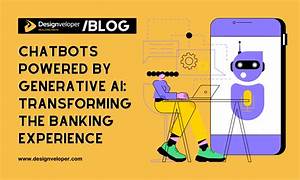AI in Customer Service Chatbots for Banking: Transforming the Financial Experience
The banking industry is at the forefront of adopting artificial intelligence (AI) to enhance customer service. Among the various applications of AI, chatbots have emerged as a game-changing technology, transforming how banks interact with their customers. These AI-powered virtual assistants provide instant, efficient, and personalized support, significantly improving the customer experience while optimizing operational efficiency for financial institutions.
This article delves into the role of AI-driven chatbots in banking, their key features, benefits, challenges, and their transformative impact on the financial services landscape.
What Are AI-Powered Customer Service Chatbots?
AI-powered chatbots are virtual assistants that leverage natural language processing (NLP), machine learning (ML), and advanced algorithms to communicate with users in real time. In the banking sector, these chatbots are designed to handle customer inquiries, provide financial advice, and facilitate banking transactions through text or voice interactions.
Unlike traditional automated systems, AI chatbots understand context, learn from interactions, and adapt to users’ preferences, offering a seamless and human-like customer service experience.
Key Features of Banking Chatbots
- 24/7 Availability
AI chatbots are available round the clock, enabling customers to access banking services anytime, anywhere. - Multilingual Support
Chatbots can communicate in multiple languages, catering to a diverse customer base. - Personalized Interactions
By analyzing customer data, chatbots offer tailored financial advice and recommendations, enhancing user engagement. - Transaction Capabilities
Many chatbots facilitate basic banking tasks such as fund transfers, bill payments, and balance inquiries. - Fraud Detection Alerts
Chatbots can notify customers of suspicious activities and assist them in securing their accounts. - Natural Language Understanding (NLU)
Advanced NLP allows chatbots to comprehend user queries, even when phrased differently, ensuring accurate responses. - Integration with Banking Systems
Chatbots seamlessly integrate with core banking systems to provide real-time account updates and support. - Voice-Enabled Assistance
Voice-enabled chatbots enhance accessibility, particularly for visually impaired or on-the-go users.
How AI Chatbots Enhance Customer Service in Banking
- Instant Query Resolution
Chatbots provide immediate responses to common customer queries, such as account balances, loan details, and transaction histories, reducing wait times. - Enhanced Customer Engagement
AI-driven chatbots engage users with conversational interactions, building trust and loyalty. - Scalability
Unlike human agents, chatbots can handle thousands of simultaneous interactions, making them ideal for large customer bases. - Cost Efficiency
By automating repetitive tasks, chatbots reduce the workload on human agents, leading to significant cost savings. - Proactive Support
Chatbots can send timely reminders for bill payments, loan EMIs, or investment opportunities, helping customers stay on top of their finances. - Streamlined Onboarding
New customers can complete onboarding processes, including KYC verification, with the help of chatbots, simplifying the experience. - Fraud Prevention and Security
By analyzing patterns in user behavior, chatbots can identify potential fraud and alert customers promptly.
Benefits of AI-Powered Chatbots in Banking
- Improved Customer Satisfaction
With instant and accurate support, chatbots enhance customer satisfaction and retention. - Accessibility
Chatbots are accessible via various platforms, including mobile apps, websites, and messaging services like WhatsApp and Facebook Messenger. - Consistency
AI chatbots provide uniform responses, eliminating inconsistencies in customer service. - Data Insights
Chatbots collect and analyze customer data, offering banks valuable insights into user behavior and preferences. - Reduced Human Error
Unlike human agents, chatbots do not make errors due to fatigue or oversight, ensuring reliable service. - Eco-Friendly
By reducing reliance on physical branches and paper-based processes, chatbots contribute to a greener banking ecosystem.
Real-Life Applications of Chatbots in Banking
- HDFC Bank’s EVA
EVA (Electronic Virtual Assistant) is an AI chatbot that answers millions of customer queries with high accuracy, offering real-time solutions. - Bank of America’s Erica
Erica is a virtual assistant that helps customers with budgeting, bill payments, and account monitoring through conversational AI. - HSBC’s Amy
Amy assists HSBC customers by providing information about banking products and services while ensuring a smooth user experience. - Wells Fargo Chatbot
Wells Fargo’s chatbot operates on Facebook Messenger, helping customers access account information and locate ATMs. - ICICI Bank’s iPal
iPal enables customers to perform transactions, get personalized offers, and receive financial advice, all through AI-driven interactions.
Challenges and Limitations of AI Chatbots in Banking
- Complex Query Handling
While chatbots excel at routine queries, they may struggle with complex or nuanced financial issues that require human expertise. - Data Privacy Concerns
Handling sensitive financial data raises concerns about cybersecurity and customer privacy. Banks must ensure robust encryption and compliance with data protection regulations. - Technical Glitches
Chatbots may occasionally face technical issues, leading to delays or incorrect responses. - Customer Reluctance
Some customers, particularly older generations, may prefer human interactions over AI-driven assistance. - Cultural and Linguistic Nuances
Understanding regional languages and cultural nuances remains a challenge for many chatbots. - Over-Reliance on Automation
Excessive reliance on chatbots could alienate customers who value human interaction, particularly in emotionally sensitive situations like loan rejections or account disputes.
The Future of AI Chatbots in Banking
The evolution of AI chatbots in banking is set to redefine customer service further:
- Advanced Personalization
Future chatbots will use deeper data insights to offer hyper-personalized financial recommendations. - Integration with IoT Devices
Chatbots may integrate with smart home devices, enabling voice-activated banking through gadgets like Alexa and Google Home. - Emotional Intelligence
Emerging AI models will enable chatbots to detect and respond to customer emotions, improving their empathetic abilities. - Blockchain Integration
Blockchain technology will enhance chatbot security and transparency in financial transactions. - Cross-Platform Interactions
Chatbots will seamlessly interact across platforms, allowing customers to switch devices without losing context. - Hybrid Support Models
Combining AI chatbots with human agents, hybrid models will offer the efficiency of automation with the empathy of human interaction.
Conclusion
AI-powered customer service chatbots are revolutionizing the banking industry, offering faster, smarter, and more accessible financial support. By automating routine tasks and providing personalized interactions, these virtual assistants enhance customer satisfaction while enabling banks to operate more efficiently.
While challenges such as data privacy and complex query handling remain, continuous advancements in AI and machine learning promise to address these limitations. As chatbots become more intelligent and versatile, they are poised to become indispensable tools in the banking sector, shaping the future of financial services and customer experiences.
By embracing this transformative technology, banks can build stronger relationships with their customers, ensuring trust, loyalty, and long-term success in an increasingly digital world.


